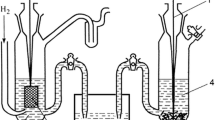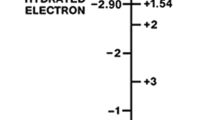Abstract
An approximate solution for the relation of the charges and potentials in a spherical cell to the production of electrolytes in the cell and their diffusion resistances is derived. The potential obtained by introducing reasonable values of the constants is of the proper order of magnitude. The equations are applied to a respiratory chain and the relation between oxygen consumption, glycolytic coefficient, and potentials is determined. Available experimental data is compared with the theory.
Similar content being viewed by others
Literature
Barnes, T. C. 1937.Textbook of General Physiology: Philadelphia: P. Blakiston's Sons.
Barnes, T. C. and T. L. Jahn. 1933. “The Effect of Ice and Steam Water on Euglena.”Proc. Nat. Acad. Sci.,19, 638–640.
Cameron, A. T. 1930.A Textbook of Biochemistry. London: J. and A. Churchill.
Gray, F. W. and J. H. Cruickshank. 1935. “Diamagnetism of Light and Heavy Water.”Nature,135, 268–269.
Gyemant, Andreas. 1925.Grundzüge der Kolloidphysik. Braunschweig: Viewig und Sohn.
Höber, R. 1936. “Membrane Permeability to Solutes in Its Relation to Cellular Physiology.”Physiol. Rev.,16, 52–102.
Joos, G. 1934.Theoretical Physics. London: Blackie and Son Ltd.
Landahl, H. D. 1939. “Mathematical Biophysics of Cell Respiration II.”Bull. Math. Biophysics 1, 1–17.
Lund, E. J. and J. B. Moorman 1931. “Electrical Polarity and Velocity of Cell Oxidation as Functions of Temperature.”Jour. Exp. Zool.,60, 249–267.
Lund, E. J. 1932a. “Control of the Flux Equilibrium of Electrochemical Processes and Electric Polarity in the Douglas Fir by Temperature.”Plant Physiology,7, 297–307.
Lund, E. J. 1932b. “Comparison of the Effects of Temperature on the Radial and Longitudinal Electric Polarities in Wood and Cortex of the Douglas Fir.”Plant Physiology,7, 505–516.
Rashevsky, N. 1935. “On Electric Charges of Disperse Systems Which Are the Seats of Physico-Chemical Reactions.”Physics,6, 33–34.
Rashevsky, N. 1938.Mathematical Biophysics: Physicomathematical Foundations of Biology. Chicago: University of Chicago Press.
Rashevsky, N. 1940.Advances and Applications of Mathematical Biology. Chicago: University of Chicago Press.
Reiner, J. 1937. “Diffusion and Biological Membrane Permeability I”.Growth,1, 313–327.
Williamson, Robert R. 1939. “A Comparison of Electrical and Diffusion Forces in the Metabolism of Electrolytes.”Bull. Math. Biophysics,1, 151–157.
Author information
Authors and Affiliations
Rights and permissions
About this article
Cite this article
Williamson, R.R. Electrical charges and potentials in cells resulting from metabolism of electrolytes. Bulletin of Mathematical Biophysics 3, 79–87 (1941). https://doi.org/10.1007/BF02478164
Issue Date:
DOI: https://doi.org/10.1007/BF02478164




